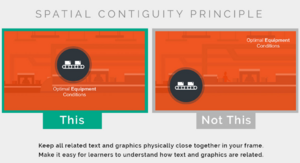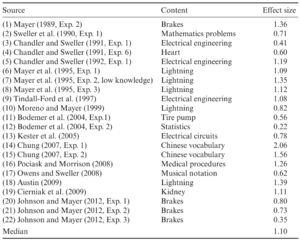Spatial Contiguity Principle
Overview
Students learn better when corresponding words and pictures are presented near each other than far from each other on the page or screen(Mayer et al. 1989).
As one of Mayer's 12 Principles of Multimedia Learning, the Spatial Contiguity Principle refers to a close together distance in the actual space between relevant text and visuals on the screen. When the corresponding words and pictures are far from each other, we define it as separated presentation. Spatial contiguity is created when we use an integrated presentation in which each illustration is placed next to the text that describes it, and words have been inserted into the illustration. By this, Learners have cues for combining corresponding words and images that save their working memory during cognitive processing. This principle is important to consider when developing e-learning modules because it allows for meaningful learning by creating a mental connection between words and images.
Evidence
Placing printed words near the graphics they describe to guide the learner's cognitive processing helps to reduce extraneous processing.
There are 22 tests of the spatial contiguity principle in the research(Table 12.7). For example, in Mayer's study(1989), students trad a paper-based lesson on how brakes work and then need to take a transfer test. Some of the students(Integrated group) were provided with words describing the action and were placed next to the corresponding part of an illustration. Others(Separated groups) received each picture that was placed at the top of a page and the corresponding words were separated and placed in a paragraph at the bottom of the page. The result shows that the integrated group performed much better than the separated group on a transfer test.
Reference
Mayer’s 12 Principles of Multimedia Learning: Introduction. (n.d.-b). https://www.skillsandparticipation.co.uk/mod/book/view.php?id=11085



